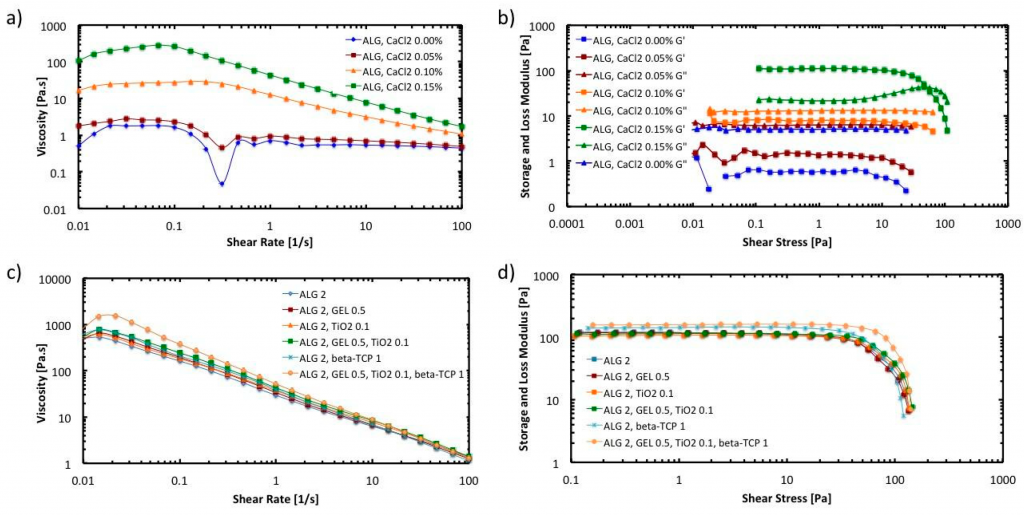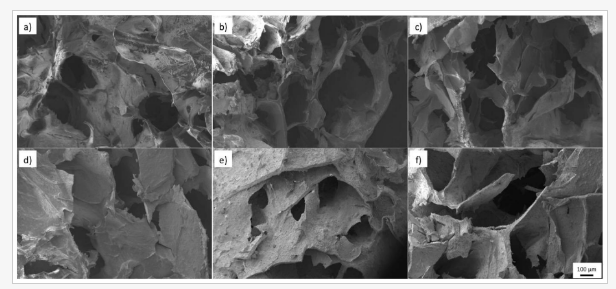
Illustration of printing process of the scaffolds. From synthesis of the solution, computer-aided design, extrusion computer-controlled, crosslinking of the scaffold and crosslinked printed design.
Alginate, often used in research as it can be molded into stable structures, now plays a part in a study performed by scientists in Mexico, creating porous networks with hydrogels and outlining their findings in ‘Alginate/Gelatin Hydrogels Reinforced with TiO2 and β-TCP Fabricated by Microextrusion-based Printing for Tissue Regeneration.’
Hydrogel scaffolds have the potential to offer biocompatibility, methods for synthesis, required degradability, and more; however, as the researchers point out, the use of alginates does present obstacles:
“Some of the challenges with respect to alginates designed for additive manufacturing (3D printing) are the printability, accuracy, and shape fidelity of the hydrogel scaffolds,” state the researchers. “These problems are associated with the rheological properties of the alginate solution, where a weak structure of the hydrogel ink can compromise the mechanical properties, making it difficult for the hydrogel to retain a shape in a predesigned geometry.”
In this project, the research team used both alginate and gelatin hydrogels—reinforced with TiO2 and β-tricalcium phosphate—to customize structures for 3D printing. Due to the enhancements, mechanical properties were strengthened as envisioned, up to 20 MPa of elastic modulus, with pores measuring an average size of 200 μm. Scaffolds were created in Rhinoceros 5.0, using the Grasshopper plugin. Three types were made:
- Grid
- Voronoi
- Hexagons
Parameters included:
- Line thickness (0.40–0.60 mm)
- Cell size (depending on the cell number)
- Cell number (25-35)
The RepRap Mendelmax 3D printer was used in fabrication, and scaffolds were created at a layer height of 0.15 mm, with a shell thickness of 0.25 mm, and continuous flow of 100 percent. As the researchers point out in their paper, physicochemical parameters determining the printability of a hydrogel are known as its rheological properties. In this research, they were characterized using a plate rheometer.

Rheology tests: (a) Flow curve for pre-crosslinked hydrogel inks; (b) Amplitude sweep for pre-crosslinked hydrogel inks; (c) Flow curve of hydrogels with different compositions with 0.20% of pre-crosslinker; (d) Amplitude sweep (Storage modulus) of hydrogels with different compositions with 0.20% of pre-crosslinker.
“The viscosity of the hydrogel inks is plotted as a function of the shear rate. It was found that altering the concentration of calcium chloride resulted in a practical method of controlling the viscosity of the alginate ink,” state the researchers. “As the concentration of calcium chloride gets higher, the viscosity of the hydrogel increases due to a higher percentage of crosslinked alginate molecules ionically bonded with calcium.”
In this case, the hydrogel ink demonstrates shear-thinning also, made obvious as viscosity lessens and shear rate grows—caused by polymer chain reorganization that causes stretching, straightening and decrease in viscosity; however, printing accuracy increases as viscosity does.
“Overall, the rheological properties of the hydrogel inks are favorable for the extrusion process in the 3D printer,” stated the researchers. “In the syringe, the hydrogel chains form a temporary network with high viscosity. Upon disposing through a needle, the network is broken up by shear and the polymer chains align, reducing the viscosity by orders of magnitude. Directly after removal of shear stress, the network is restored, resulting in a high printing fidelity upon deposition.”
All hydrogels exhibited high porosity, and as the researchers explain further, this a desired property. When gelatin in HG-2, or TiO2 nanopowder in HG-3 is added, however, pore size decreases. This is due to greater polymer chain entanglement and transformation in the internal structure of the hydrogels. The research team states that even so, the pore size and standard deviation are still adequate for encouraging cell growth.
As for tensile testing, the highest elastic modulus was achieved through adding TiO2 (HG-4), 20 MPa, with the researchers noting that adding gelatin and nanoparticles had no effect on viscoelastic properties; however, it did make a difference in the mechanical properties of subsequent, crosslinked alginate. They also noted that once gelatin is combined with the pre-crosslinked alginate solution, printability is not affected.
“The study provides new insights into the possibilities of alginate/gelatin added with TiO2 nanoparticles and β-TCP composite hydrogel 3D printing for tissue regeneration, where further assays are being made to prove cytotoxicity, cell proliferation, and bioactivity of the material,” concluded the researchers.
Bioprinting with the use of scaffolds is both a growing science and an art as researchers seek to re-create organs in the lab, and engineer tissue for many different uses such as making bone, creating facial implants, promoting cartilage regrowth, and so much more. Find out more about the use of alginate and hydrogels here. Discuss this article and other 3D printing topics at 3DPrintBoard.com.
[Source / Images: Alginate/Gelatin Hydrogels Reinforced with TiO2 and β-TCP Fabricated by Microextrusion-based Printing for Tissue Regeneration]Subscribe to Our Email Newsletter
Stay up-to-date on all the latest news from the 3D printing industry and receive information and offers from third party vendors.
You May Also Like
Profiling a Construction 3D Printing Pioneer: US Army Corps of Engineers’ Megan Kreiger
The world of construction 3D printing is still so new that the true experts can probably be counted on two hands. Among them is Megan Kreiger, Portfolio Manager of Additive...
US Army Corps of Engineers Taps Lincoln Electric & Eaton for Largest 3D Printed US Civil Works Part
The Soo Locks sit on the US-Canadian border, enabling maritime travel between Lake Superior and Lake Huron, from which ships can reach the rest of the Great Lakes. Crafts carrying...
Construction 3D Printing CEO Reflects on Being Female in Construction
Natalie Wadley, CEO of ChangeMaker3D, could hear the words of her daughter sitting next to her resounding in her head. “Mum, MUM, you’ve won!” Wadley had just won the prestigious...
1Print to Commercialize 3D Printed Coastal Resilience Solutions
1Print, a company that specializes in deploying additive construction (AC) for infrastructure projects, has entered an agreement with the University of Miami (UM) to accelerate commercialization of the SEAHIVE shoreline...































